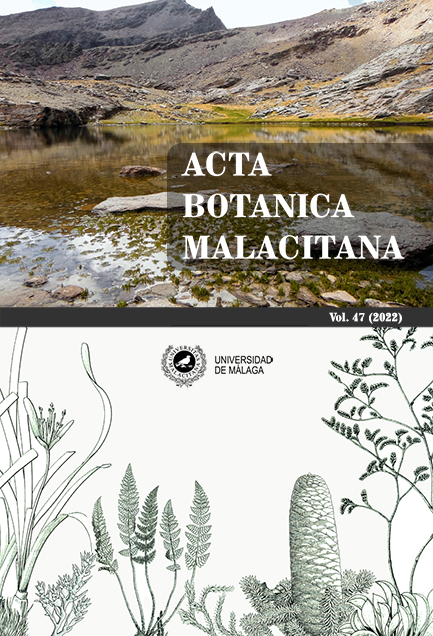Las tres Floras de Salvador Talavera
DOI:
https://doi.org/10.24310/abm.v47i.15357Keywords:
Salvador Talavera, Iberian flora, in memory, workAbstract
In memory of Salvador Talavera, an analysis of his contributions to the three realities of Iberian flora is presented: research, scientific project and scientific literary work.Downloads
Metrics
References
Aedo, C. (2021). Preámbulo. En C. Romero Zarco et al. (eds.), Flora iberica vol. XIX(II) Gramineae (partim), páginas XI-XIII. Madrid: CSIC-Jardín Botánico de Madrid.
Arroyo, J., Devesa, J.A., Herrera, J., Ortiz, P. & Talavera, S. (1986). Resumen del proyecto de investigación: La Flora Melitófila de Andalucía Occidental. Vida Apícola 18, 33-39.
Balao, F., Navarro-Sampedro, L., Berjano, R., García-Castaño, J.L., Casimiro-Soriguer, R., Talavera, M., Talavera, S. & Terrab, A. (2017). Riverine speciation and long dispersal colonization in the Ibero-African Onopordum dissectum complex (Asteraceae). Botanical Journal of the Linnean Society 183(4), 600-615.
Molina-Venegas, R., Aparicio, A., Pina, F.J., Valdés, B. & Arroyo, J. (2013). Disentangling environmental correlates of vascular plant biodiversity in a Mediterranean hotspot. Ecology and Evolution 2013, 3(11), 3879–3894. doi: 10.1002/ece3.762
Talavera, S. (1974). Contribución al estudio cariológico del género Cirsium (Compositae) en la Península Ibérica. Lagascalia 4(2), 285-296.
Talavera, S. (1976). Revisión de las especies españolas del género Biarum Schott. Lagascalia 6(2), 275-296.
Talavera, S. (1977a). Notas sobre el género Silene L. en España: III. Silene mariana Pau. Lagascalia 7(2), 127-131.
Talavera, S. (1977b). Aportación al estudio cariológico de gramíneas españolas. Lagascalia 7(2): 133-142.
Talavera, S. (1978). Revisión de la sect. Erectorefrac-tae Chowdhuri del género Silene L. Lagascalia 8(2), 135-164.
Talavera, S & Bocquet, G. (1975). Notas sobre el género Silene L. en España: I. Números crosómi-cos de la sect. Scorpioideae (Rohr.) Chowdhuri. Lagascalia 5(1), 47-54.
Talavera, S. & Bocquet, G. (1976). Notas sobre el género Silene L. en España: II. Números crosómi-cos de las especies españolas (excep. sect. Scorpioideae y Silene vulgaris). Lagascalia 6(1), 101-116.
Talavera, S. & Candau, P. (1978). Polen y semillas de la sect. Erectorefractae Chowdhuri del género Silene L. en España. Lagascalia 8(2), 127-133.
Talavera, S. & Valdés, B. (1976). Revisión del género Cirsium (Compositae) en la Península Ibérica. Lagascalia 5(2), 127-223.
Talavera, S., Herrera, J., Arroyo, J., Ortiz, P. & Devesa, J.A. (1988). Estudio de la Flora Apícola de Andalucía Occidental. Lagascalia 15 (Tomo Extra), 567-596.
Tremetsberger, K., Talavera, S., Stuessy, T.F., Ortiz, M.Á., Weiss-Schneeweis, H. & Kadlec, G. (2004). Relationship of Hypochaeris salzmanniana (Asteraceae, Lactuceae), an endangered species of the Iberian Peninsula, to H. radicata and H. glabra and biogeographical implications. Botanical Journal of the Linnean Society 146, 79-95.
Downloads
Published
How to Cite
Issue
Section
License
All information related to the licensing of published works in Acta Botanica Malacitana and copyright can be found in our Editorial Policy.







1.png)
